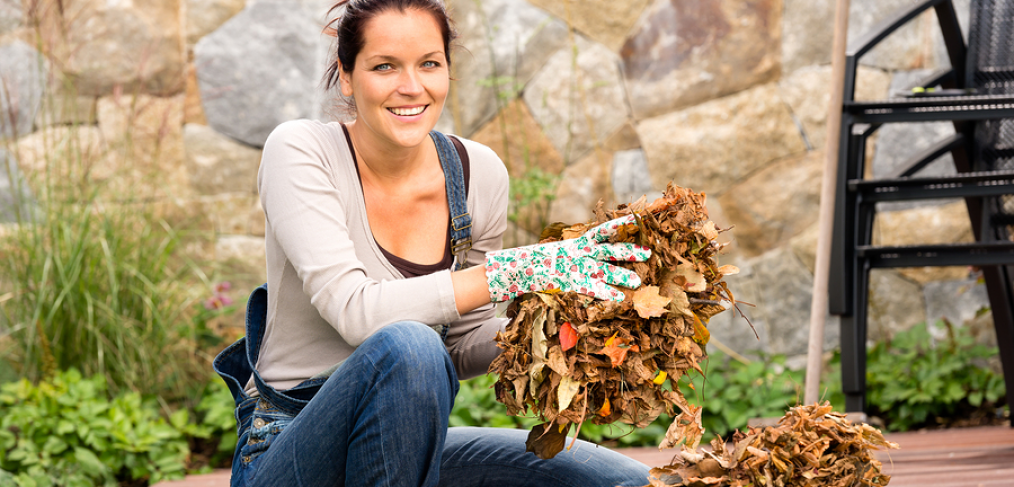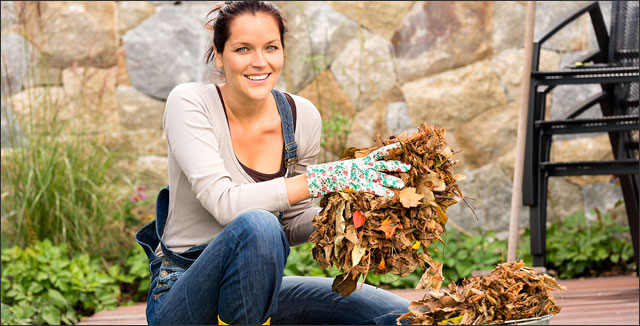
Fall Garden Clean Up Guide – Backyard Gardening

It’s that time of year again. Fall clean up time.
You’ve inhaled the lush fragrances and bathed in the vibrant colors. You’ve cleaned the dirt from your fingers and looked with satisfaction over all your hard work.
Finally, you’ve tasted the literal fruits of your labors and shared them with friends.
The last warm, sunny days are passing us by. The leaves have just turned past their highest blaze of glory and are starting to fall in earnest.
And all over the country, Americans are getting out into their yards and cleaning up their gardens, lawns, trees, and flower beds.
It’s a bittersweet time of year. Though you might have a few vegetables still in the ground and some green tomatoes to turn into chutney, the best days are behind us until the next growing season.
You might be thinking your vegetable garden looks like a bit of a mess. Your tomato plants have fallen, your squash vines are all brown and wilted, and your hostas are just big bushes of dry, yellowing leaves.
Although the trees are beautiful, we know we have to live through another long winter.
However, there’s still work to be done!
It’s time to look forward to next year. It’s time to set up next season’s garden for success while you can. And, it is time to clean up, pull up, put away, and plant.
With this in mind, we put today’s article together to provide our readers with the tips and tricks they need to know for their fall clean up.
Your Fall Clean Up Guide
Flower Garden Tasks
Our friends at Organic Gardening recommend first to clean up your annuals and to weed before the seeds falling.
Take out your summer mulch and compost, deadhead all your flowering plants, and get rid of the weeds. Then rake up fallen leaves and debris.
If you’ve already had a hard frost, or if your annuals are dead, now is the time to dig up your annuals and compost the healthy plants.
Take care of your perennials by splitting up clumps and separating any rhizomes that have gotten too big. Then add compost.
Prune any perennials that need it.
Plant biennial seeds like foxglove, violets, and hollyhock
Plant your spring flower bulbs. Find out how to do just that by visiting Backyard Gardening Tips: How to Plant Spring Flowering Bulbs.
Add manure or compost and mulch with 2-3 inches of fresh mulch.
Lawn Care
According to Better Homes and Gardens, it’s time to lower the height on your lawnmower because shorter helps the soil to dry out before spring more quickly.
Fertilize your lawn in the fall months. Why? According to This Old House, fertilizing in the fall will strengthen the roots of your plants and grass. This will give them a “strong base on which to thrive next spring.”
Weeds like ground ivy, plantain and dandelion are most vulnerable to weed killers in the fall. Herbicides are, however, potentially dangerous to your lawn as well as nearby animals and even humans. On the flip side, these plants can be pulled out by hand at any time!
Continue mowing! For most healthy lawns and trees, you can use your mower’s mulching mode to mulch the dead leaves right where they sit. They will slowly fertilize your lawn!
However, if your tree has a fungal disease (which you can see by the brown spots on the leaves), you need to remove and burn the leaves to prevent it from spreading on the wind to the tree’s new buds next year.
Lay seed on your lawn now to help it get a head start when spring comes. Cover your seeds with straw or mulch to prevent birds from eating them
Fall and winter are also good times to lay seed so that your lawn gets a head start in the spring.
Do you know how to dethatch and aerate your lawn, and why you should?
Thatch is a layer of dead grass that is too thick to decompose quickly enough and keep your growing grass roots from getting the water they need.
Break up these thatches with a rake and aerate your lawn by pulling small cores of soil. Make sure you have the right kind of grass, or this can damage it!
Water your lawn thoroughly! If your yard has suffered drought, it can be damaged by the cold in the winter and not bounce back.
Vegetable Garden Tasks
The Old Farmer’s Almanac reports that while you can leave carrots, garlic, leeks, parsnips, and radishes and turnips in the ground through early winter, make sure you pull up your tomatoes, pea, bean and squash plants.
If any of the vegetables that are pulled up are diseased, make sure to discard them by burning them or getting rid of them separately.
Removing dead plants and weeds and turning over the soil once again helps to prevent disease.
Read our post on how to winterize your garden!
Tree and Shrub Care
Did you know that fall is the best time to plant trees and shrubs? This is because it gives trees and shrubs enough time to establish their roots before springtime.
Add mulch to your garden bed and around your trees and shrubs.
To learn how to choose the right mulch, please see: How to Choose the Right Mulch for Your Landscaping
Save money by using the mulch you already have. Grass and shredded leaves provide tons of nutrients and make for a great mulch.
If your leaves have a fungal disease, which can make its way to the new buds in the spring, rake them up and burn them.
Protect your trees from rodents through the winter using a ½ inch mesh hardware cloth around the base of your tree. They like to eat the bark of young trees in the winter.
Apply mulch around the base of your tree if you live in Northern climates
Water and prune your shrubs and trees
Takeaway
With these few fall clean up tasks, you can make sure you start spring garden right and prevent the spread of disease to your perennials, trees, shrubs, or next year’s plants. Happy fall gardening, everyone!
Are you wondering what aeration tubes are? Find your answer here -> Scientific Study Proves Rootwell Watering System Works.



